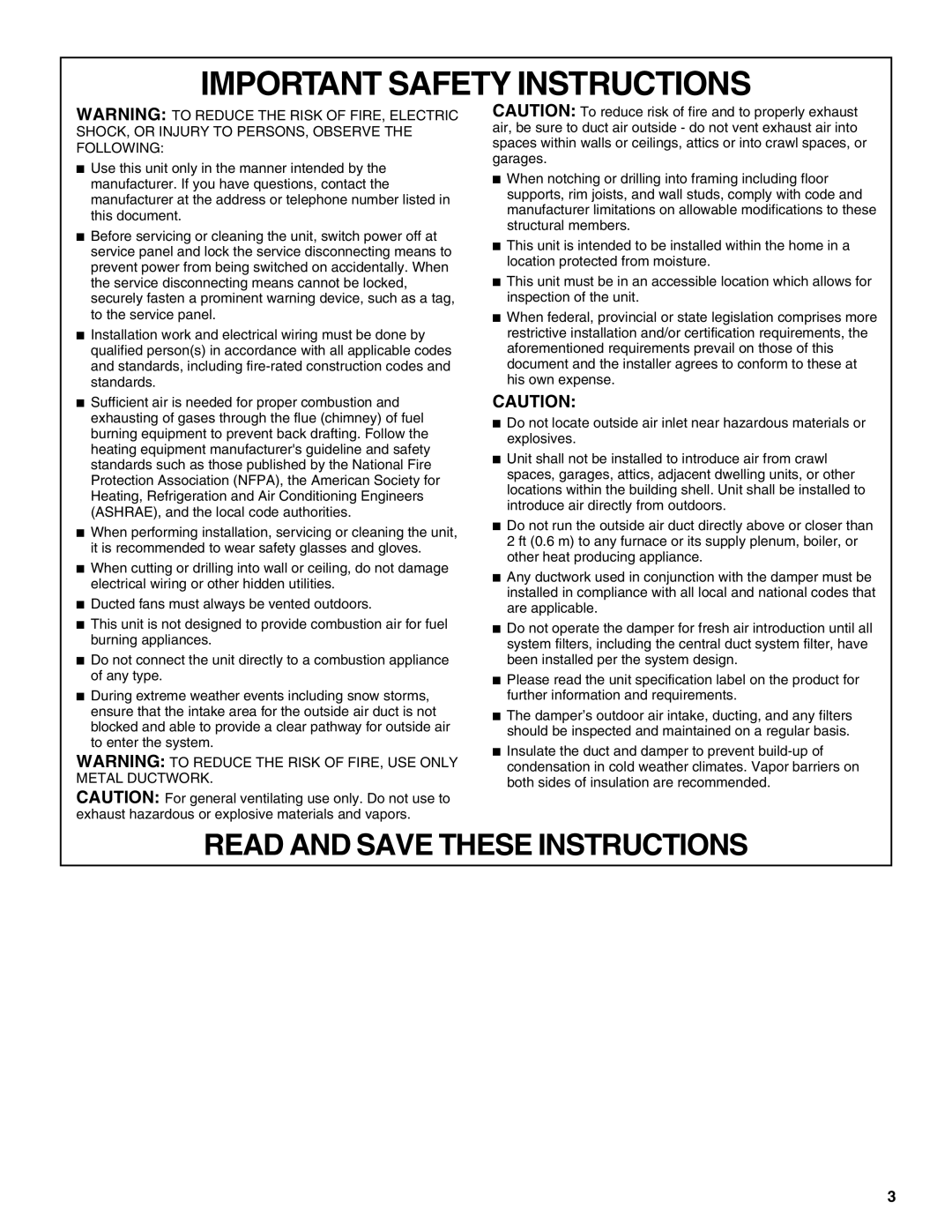
IMPORTANT SAFETY INSTRUCTIONS
WARNING: TO REDUCE THE RISK OF FIRE, ELECTRIC SHOCK, OR INJURY TO PERSONS, OBSERVE THE FOLLOWING:
■Use this unit only in the manner intended by the manufacturer. If you have questions, contact the manufacturer at the address or telephone number listed in this document.
■Before servicing or cleaning the unit, switch power off at service panel and lock the service disconnecting means to prevent power from being switched on accidentally. When the service disconnecting means cannot be locked, securely fasten a prominent warning device, such as a tag, to the service panel.
■Installation work and electrical wiring must be done by qualified person(s) in accordance with all applicable codes and standards, including
■Sufficient air is needed for proper combustion and exhausting of gases through the flue (chimney) of fuel burning equipment to prevent back drafting. Follow the heating equipment manufacturer's guideline and safety standards such as those published by the National Fire Protection Association (NFPA), the American Society for Heating, Refrigeration and Air Conditioning Engineers (ASHRAE), and the local code authorities.
■When performing installation, servicing or cleaning the unit, it is recommended to wear safety glasses and gloves.
■When cutting or drilling into wall or ceiling, do not damage electrical wiring or other hidden utilities.
■Ducted fans must always be vented outdoors.
■This unit is not designed to provide combustion air for fuel burning appliances.
■Do not connect the unit directly to a combustion appliance of any type.
■During extreme weather events including snow storms, ensure that the intake area for the outside air duct is not blocked and able to provide a clear pathway for outside air to enter the system.
WARNING: TO REDUCE THE RISK OF FIRE, USE ONLY METAL DUCTWORK.
CAUTION: For general ventilating use only. Do not use to exhaust hazardous or explosive materials and vapors.
CAUTION: To reduce risk of fire and to properly exhaust air, be sure to duct air outside - do not vent exhaust air into spaces within walls or ceilings, attics or into crawl spaces, or garages.
■When notching or drilling into framing including floor supports, rim joists, and wall studs, comply with code and manufacturer limitations on allowable modifications to these structural members.
■This unit is intended to be installed within the home in a location protected from moisture.
■This unit must be in an accessible location which allows for inspection of the unit.
■When federal, provincial or state legislation comprises more restrictive installation and/or certification requirements, the aforementioned requirements prevail on those of this document and the installer agrees to conform to these at his own expense.
CAUTION:
■Do not locate outside air inlet near hazardous materials or explosives.
■Unit shall not be installed to introduce air from crawl spaces, garages, attics, adjacent dwelling units, or other locations within the building shell. Unit shall be installed to introduce air directly from outdoors.
■Do not run the outside air duct directly above or closer than 2 ft (0.6 m) to any furnace or its supply plenum, boiler, or other heat producing appliance.
■Any ductwork used in conjunction with the damper must be installed in compliance with all local and national codes that are applicable.
■Do not operate the damper for fresh air introduction until all system filters, including the central duct system filter, have been installed per the system design.
■Please read the unit specification label on the product for further information and requirements.
■The damper’s outdoor air intake, ducting, and any filters should be inspected and maintained on a regular basis.
■Insulate the duct and damper to prevent
READ AND SAVE THESE INSTRUCTIONS
3
